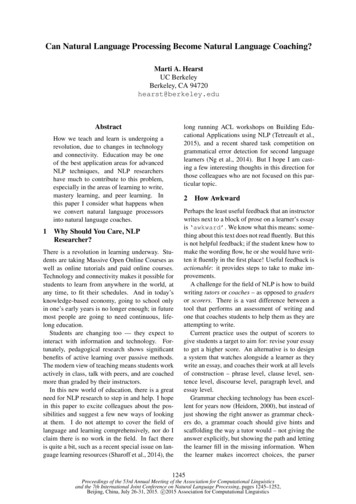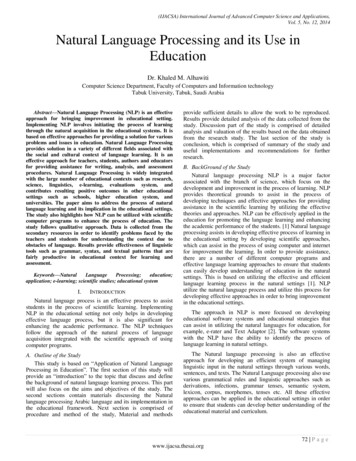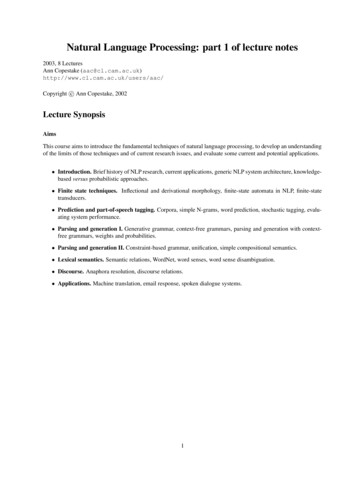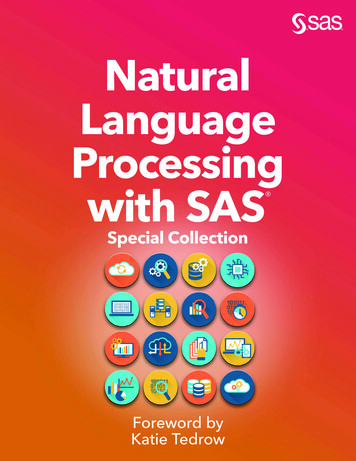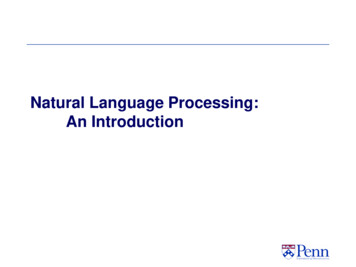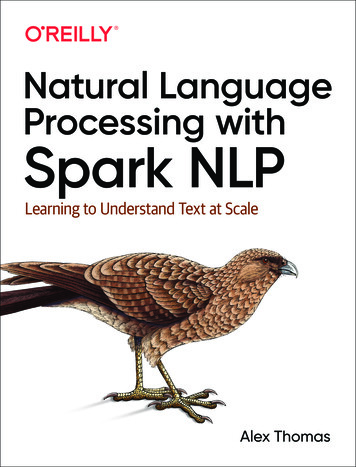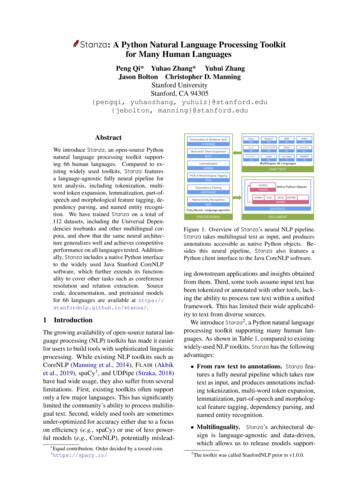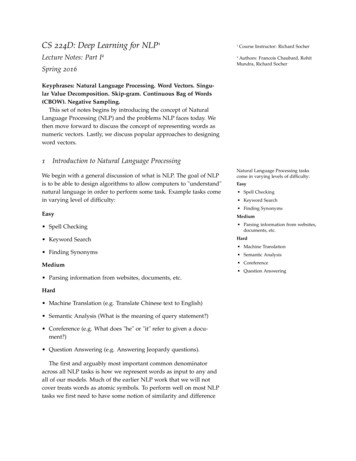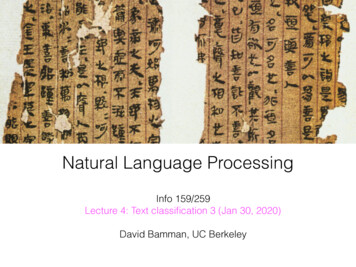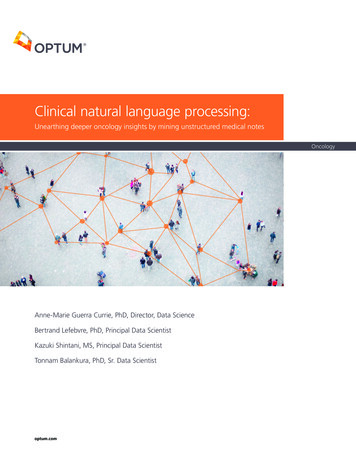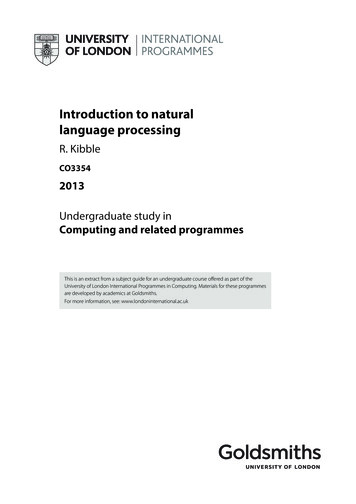
Transcription
Introduction to naturallanguage processingR. KibbleCO33542013Undergraduate study inComputing and related programmesThis is an extract from a subject guide for an undergraduate course offered as part of theUniversity of London International Programmes in Computing. Materials for these programmesare developed by academics at Goldsmiths.For more information, see: www.londoninternational.ac.uk
This guide was prepared for the University of London International Programmes by:R. KibbleThis is one of a series of subject guides published by the University. We regret that due to pressure of work the author isunable to enter into any correspondence relating to, or arising from, the guide. If you have any comments on this subjectguide, favourable or unfavourable, please use the form at the back of this guide.University of London International ProgrammesPublications Office32 Russell SquareLondon WC1B 5DNUnited Kingdomwww.londoninternational.ac.ukPublished by: University of LondonCopyright Department of Computing, Goldsmiths 2013The University of London and Goldsmiths assert copyright over all material in this subject guide except where otherwiseindicated. All rights reserved. No part of this work may be reproduced in any form, or by any means, without permission inwriting from the publisher. We make every effort to respect copyright. If you think we have inadvertently used your copyrightmaterial, please let us know.
ContentsPrefaceAbout this half unit . . . . . . . . . . . . . . . .Assessment . . . . . . . . . . . . . . . . . . . .The subject guide and other learning resourcesSuggested study time . . . . . . . . . . . . . . .Acknowledgement . . . . . . . . . . . . . . . .1112231 Introduction: how to use this subject guide1.1 Introduction . . . . . . . . . . . . . . . . . . . . . . . . . . . . . . . . .1.2 Aims of the course . . . . . . . . . . . . . . . . . . . . . . . . . . . . .1.3 Learning outcomes . . . . . . . . . . . . . . . . . . . . . . . . . . . . .1.4 Reading list and other learning resources . . . . . . . . . . . . . . . . .1.5 Software requirements . . . . . . . . . . . . . . . . . . . . . . . . . . .1.6 How to use the guide/structure of the course . . . . . . . . . . . . . .1.6.1 Chapter 2: Introducing NLP: patterns and structures in language1.6.2 Chapter 3: Getting to grips with natural language data . . . . .1.6.3 Chapter 4: Computational tools for text analysis . . . . . . . . .1.6.4 Chapter 5: Statistically-based techniques for text analysis . . .1.6.5 Chapter 6: Analysing sentences: syntax and parsing . . . . . .1.6.6 Appendices . . . . . . . . . . . . . . . . . . . . . . . . . . . . .1.7 What the course does not cover . . . . . . . . . . . . . . . . . . . . . .555668888999992 Introducing NLP: patterns and structure in languageEssential reading . . . . . . . . . . . . . . . . . . . . . . . . . . . . . .Recommended reading . . . . . . . . . . . . . . . . . . . . . . . . . . .Additional reading . . . . . . . . . . . . . . . . . . . . . . . . . . . . .2.1 Learning outcomes . . . . . . . . . . . . . . . . . . . . . . . . . . . . .2.2 Introduction . . . . . . . . . . . . . . . . . . . . . . . . . . . . . . . . .2.3 Basic concepts . . . . . . . . . . . . . . . . . . . . . . . . . . . . . . . .2.3.1 Tokenised text and pattern matching . . . . . . . . . . . . . . .Activity: Recognising names . . . . . . . . . . . . . . . . . . . . . . . .2.3.2 Parts of speech . . . . . . . . . . . . . . . . . . . . . . . . . . .Activity: identify parts of speech . . . . . . . . . . . . . . . . . . . . .2.3.3 Constituent structure . . . . . . . . . . . . . . . . . . . . . . . .Activity: Writing production rules . . . . . . . . . . . . . . . . . . . . .2.4 A closer look at syntax . . . . . . . . . . . . . . . . . . . . . . . . . . .2.4.1 Operation of a finite-state machine . . . . . . . . . . . . . . . .Activity: Finite-state machines . . . . . . . . . . . . . . . . . . . . . . .2.4.2 Representing finite-state machines . . . . . . . . . . . . . . . .2.4.3 Declarative alternatives to finite-state machines . . . . . . . . .Activity: Coding regular expressions . . . . . . . . . . . . . . . . . . .Activity: tree diagrams for a regular language . . . . . . . . . . . . . .2.4.4 Limitations of finite-state methods – introducing context-freegrammars . . . . . . . . . . . . . . . . . . . . . . . . . . . . . .Activity: Regular grammars . . . . . . . . . . . . . . . . . . . . . . . .Activity: Context-free grammar . . . . . . . . . . . . . . . . . . . . . .2.4.5 Looking ahead: some further uses of regular expressions . . . .111111111112121213131414151516171718192121212323i
CO3354 Introduction to natural language processing2.4.6 Looking ahead: grammars and parsing2.5 Word structure . . . . . . . . . . . . . . . . .Activity: Past tense formation . . . . . . . . .2.6 A brief history of natural language processing2.7 Summary . . . . . . . . . . . . . . . . . . . .2.8 Sample examination questions . . . . . . . .ii.3 Getting to grips with natural language dataEssential reading . . . . . . . . . . . . . . . . . . . . . . . . . .Recommended reading . . . . . . . . . . . . . . . . . . . . . . .Additional reading . . . . . . . . . . . . . . . . . . . . . . . . .3.1 Learning outcomes . . . . . . . . . . . . . . . . . . . . . . . . .3.2 Using the Natural Language Toolkit . . . . . . . . . . . . . . . .3.3 Corpora and other data resources . . . . . . . . . . . . . . . . .3.4 Some uses of corpora . . . . . . . . . . . . . . . . . . . . . . . .3.4.1 Lexicography . . . . . . . . . . . . . . . . . . . . . . . .3.4.2 Grammar and syntax . . . . . . . . . . . . . . . . . . . .3.4.3 Stylistics: variation across authors, periods, genres andnels of communication . . . . . . . . . . . . . . . . . . .3.4.4 Training and evaluation . . . . . . . . . . . . . . . . . .3.5 Corpora . . . . . . . . . . . . . . . . . . . . . . . . . . . . . . .3.5.1 Brown corpus . . . . . . . . . . . . . . . . . . . . . . . .3.5.2 British National Corpus . . . . . . . . . . . . . . . . . .3.5.3 COBUILD Bank of English . . . . . . . . . . . . . . . . .3.5.4 Penn Treebank . . . . . . . . . . . . . . . . . . . . . . .3.5.5 Gutenberg archive . . . . . . . . . . . . . . . . . . . . .3.5.6 Other corpora . . . . . . . . . . . . . . . . . . . . . . . .Activity: Online corpus queries . . . . . . . . . . . . . . . . . .3.5.7 WordNet . . . . . . . . . . . . . . . . . . . . . . . . . . .3.6 Some basic corpus analysis . . . . . . . . . . . . . . . . . . . .3.6.1 Frequency distributions . . . . . . . . . . . . . . . . . .Activity: Using NLTK tools . . . . . . . . . . . . . . . . . . . . .3.6.2 DIY corpus: some worked examples . . . . . . . . . . .Activity: building and analysing a DIY corpus . . . . . . . . . .3.7 Summary . . . . . . . . . . . . . . . . . . . . . . . . . . . . . .3.8 Sample examination question . . . . . . . . . . . . . . . . . . . . . . . . . . . . . . . . . . . . . . . . . . . . . .chan. . . . . . . . . . . . . . . . . . . . . . . . . . . . . . . . . . . . . . . . . . . . . . . . . . . . . . .4 Computational tools for text analysisEssential reading . . . . . . . . . . .Recommended reading . . . . . . . .Additional reading . . . . . . . . . .4.1 Introduction and learning outcomes4.1.1 Learning outcomes . . . . . .4.2 Data structures . . . . . . . . . . . .Activity: strings and sequences . . .4.3 Tokenisation . . . . . . . . . . . . . .4.3.1 Some issues with tokenisation4.3.2 Tokenisation in the NLTK . .Activity: Tokenising text . . . . . . .4.4 Stemming . . . . . . . . . . . . . . .Activity: Comparing stemmers . . . .4.5 Tagging . . . . . . . . . . . . . . . .4.5.1 RE tagging . . . . . . . . . .Activity: Tagging with REs . . . . . .4.5.2 Trained taggers and backoff 95151
4.5.3 Transformation-based tagging4.5.4 Evaluation and performance .Activity: Trained taggers . . . . . . .4.6 Summary . . . . . . . . . . . . . . .4.7 Sample examination question . . . .5 Statistically-based techniques for text analysisEssential reading . . . . . . . . . . . . . . . . . . . . . . . .Recommended reading . . . . . . . . . . . . . . . . . . . . .Additional reading . . . . . . . . . . . . . . . . . . . . . . .5.1 Learning outcomes . . . . . . . . . . . . . . . . . . . . . . .5.2 Introduction . . . . . . . . . . . . . . . . . . . . . . . . . . .5.3 Some fundamentals of machine learning . . . . . . . . . . .5.3.1 Naive Bayes classifiers . . . . . . . . . . . . . . . . .Activity: Bayes’ rule . . . . . . . . . . . . . . . . . . . . . .5.3.2 Hidden Markov models . . . . . . . . . . . . . . . .5.3.3 Information and entropy . . . . . . . . . . . . . . . .5.3.4 Decision trees and maximum entropy classifiers . . .Activity: further reading . . . . . . . . . . . . . . . . . . . .5.3.5 Evaluation . . . . . . . . . . . . . . . . . . . . . . . .5.4 Machine learning in action: document classification . . . . .5.4.1 Summary: document classification . . . . . . . . . .Activity: document classification . . . . . . . . . . . . . . .5.5 Machine learning in action: information extraction . . . . .5.5.1 Types of information extraction . . . . . . . . . . . .5.5.2 Regular expressions for personal names . . . . . . .Activity: coding regular expressions for proper names . . . .5.5.3 Information extraction as sequential classification:and NE recognition . . . . . . . . . . . . . . . . . . .Activity: chunking and NE recognition . . . . . . . . . . . .5.6 Limitations of statistical methods . . . . . . . . . . . . . . .5.7 Summary . . . . . . . . . . . . . . . . . . . . . . . . . . . .5.8 Sample examination question . . . . . . . . . . . . . . . . . . . . . . . . . . . . . . . . . . . . . . . . . . . . . . . . . . . . . . . . . . . . . . . . . . . . . . . . . . . . . . . . . . . . . . . . . . . . . . . . . . . . . . . . . . . . . . . . . . . . .chunking. . . . . . . . . . . . . . . . . . . . . . . . . .6 Analysing sentences: syntax and parsingEssential reading . . . . . . . . . . . . . . . . . . . .Recommended reading . . . . . . . . . . . . . . . . .Additional reading . . . . . . . . . . . . . . . . . . .6.1 Learning outcomes . . . . . . . . . . . . . . . . . . .6.2 Grammars and parsing . . . . . . . . . . . . . . . . .6.3 Complicating CFGs . . . . . . . . . . . . . . . . . . .6.3.1 Verb categories . . . . . . . . . . . . . . . . .Activity: Verb categories . . . . . . . . . . . . . . . .6.3.2 Agreement . . . . . . . . . . . . . . . . . . .Activity: feature-based grammar . . . . . . . . . . .6.3.3 Unbounded dependencies . . . . . . . . . . .6.3.4 Ambiguity and probabilistic grammars . . . .Activity: probabilistic grammar . . . . . . . . . . . .6.4 Parsing . . . . . . . . . . . . . . . . . . . . . . . . . .6.4.1 Recursive descent parsing . . . . . . . . . . .6.4.2 Shift-reduce parsing . . . . . . . . . . . . . .6.4.3 Parsing with a well-formed substring table . .6.4.4 Finite-state machines and context-free parsingActivity: Parsing . . . . . . . . . . . . . . . . . . . .6.5 Summary . . . . . . . . . . . . . . . . . . . . . . . 99090iii
CO3354 Introduction to natural language processing6.6 Sample examination question . . . . . . . . . . . . . . . . . . . . . . .91A Bibliography93B Glossary95C Answers to selected activitiesChapter 2: Introducing NLP: patterns and structure in natural language .Identify parts of speech, page 14 . . . . . . . . . . . . . . . . . . .Operation of a finite-state machine, page 17 . . . . . . . . . . . . .Coding regular expressions, page 19 . . . . . . . . . . . . . . . . .Regular grammars, page 21 . . . . . . . . . . . . . . . . . . . . . .Past tense forms, page 25 . . . . . . . . . . . . . . . . . . . . . . .Chapter 3: Getting to grips with natural language data . . . . . . . . . .Online corpus queries, page 37 . . . . . . . . . . . . . . . . . . . .Using NLTK tools, page 39 . . . . . . . . . . . . . . . . . . . . . . .Chapter 4: Computational tools for text analysis . . . . . . . . . . . . . .Comparing stemmers, page 48 . . . . . . . . . . . . . . . . . . . . .Tagging with REs, page 51 . . . . . . . . . . . . . . . . . . . . . . .Chapter 5: Statistically-based techniques for text analysis . . . . . . . . .Activity: Bayes’ Rule, page 59 . . . . . . . . . . . . . . . . . . . . .Chapter 6: Analysing sentences: syntax and parsing . . . . . . . . . . . .Activity: Verb categories, page 78 . . . . . . . . . . . . . . . . . . .Activity: Feature-based grammar, page 80 . . . . . . . . . . . . . .D Trace of recursive descent 105E Sample examination paper with answering guidelines107E.1 Sample examination questions . . . . . . . . . . . . . . . . . . . . . . 108E.2 Answering guidelines for sample examination questions . . . . . . . . 113iv
PrefaceAbout this half unitThis half unit course combines a critical introduction to key topics in theoretical andcomputational linguistics with hands-on practical experience of using existingsoftware tools and developing applications to process texts and access linguisticresources. The aims of the course and learning outcomes are listed in Chapter 1.This course has no specific prerequisites. There will be some programming involvedand you will need to acquire some familiarity with the Python language, but you willnot be expected to develop substantial original code or to encode specialisedalgorithms. The course involves some statistical techniques, but the onlymathematical knowledge assumed is an understanding of elementary probabilityand familiarity with the concept of logarithms.Before the advent of the world wide web, most machine-readable information wasstored in structured databases and accessed via specialised query languages such asStructured Query Language (SQL). Nowadays the situation is reversed: mostinformation is found in unstructured or semi-structured natural language documentsand there is increasing demand for techniques to ‘unlock’ this data. Computinggraduates with knowledge of natural language processing techniques are findingemployment in areas such as text analytics, sentiment analysis, topic detection andinformation extraction.AssessmentThe course is assessed via an unseen written examination. A sample examinationpaper is provided in the Appendix at the end of this subject guide, with someguidelines on how to answer the questions. You will be required to attempt threequestions out of a choice of five. The questions will cover ‘book knowledge’, problemsolving and short essays on more theoretical topics. The examination is not amemory test but will be designed to assess your understanding of the coursecontent. There will also be coursework which will include a similar mix of questions,but with a stronger focus on practical problem-solving.You will be expected to provide electronic copies of your coursework for plagiarismchecking purposes. It is very important that any material that is not original to youshould be properly attributed and placed in quotation marks, with a full list ofreferences at the end of your submission. You should follow the style used in thissubject guide for citing references, for example:Segaran (2007, pp.117–118) discusses some problems with rule-based spam filters.Answers which consist entirely or mostly of quoted material are unlikely to get manymarks even if properly attributed, as simply reproducing an answer in someoneelse’s words does not demonstrate that you have fully understood the material.In order to give you some practice in problem-solving and writing short essays, there1
CO3354 Introduction to natural language processingare a number of Activities throughout this subject guide. The Appendix includes asection ‘Answers to selected activities’, although these will not always providecomplete answers to the questions but are intended to indicate how particular typesof questions should be approached. Sample examination questions are provided atthe end of each chapter. Some, but not all, of these are included in the sampleexamination paper with suggested answers at the end of the guide.The subject guide and other learning resourcesThis subject guide is not intended as a self-contained textbook but sets out specifictopics for study in the CO3354 half unit. There is a recommended textbook and anumber of other readings are listed at appropriate places. There are also links towebsites providing useful resources such as software tools and access to onlinelinguistic data. The learning outcomes listed in the next chapter assume that you areworking through the recommended readings, activities and sample examinationquestions. It will not be possible to pass this half unit by reading only the subjectguide. Please refer to the Computing VLE for other resources, which should be usedas an aid to your learning.Suggested study timeThe Student Handbook states that ‘To be able to gain the most benefit from theprogramme, it is likely that you will have to spend at least 300 hours studying foreach full unit, though you are likely to benefit from spending up to twice this time’.Note that this subject is a half unit.The course is designed to be delivered over a ten-week term as one of fourconcurrent modules, and this guide has six chapters. Chapter 1 goes into more detailabout the structure of the guide and the course, while Chapters 2 to 6 are eachdedicated to a particular topic. It is suggested that you spend about two weeks onChapters 1 and 2 together and each of Chapters 3 to 6, including the associatedreading and web-based material, and work through the activities and sampleexamination questions during this time.2
ContentsAcknowledgementThis subject guide draws closely on:Bird, S., E. Klein and E. Loper, Natural Language Processing with Python. (O’ReillyMedia 2009) [ISBN 9780596516499; http://nltk.org/book].You will be expected to draw on it in your studies and to use the accompanyingsoftware package, the Natural Language Toolkit, which requires the Pythonlanguage. Natural language processing with Python has been made available underthe terms of the Creative Commons Attribution Noncommercial No-Derivative-Works3.0 US License: s/legalcode (lastvisited 13th April 2013).3
CO3354 Introduction to natural language processing4
Chapter 1Introduction: how to use this subject guide1.1IntroductionThe idea of computers being able to understand ordinary languages and holdconversations with human beings has been a staple of science fiction since the firsthalf of the twentieth century and was envisaged in a classic paper by Alan Turing(1950) as a hallmark of computational intelligence. Since the start of thetwenty-first century this vision has been starting to look more plausible: artificialintelligence techniques allied with the scientific study of language have emergedfrom universities and research laboratories to inform a variety of industrial andcommercial applications. Many websites now offer automatic translation; mobilephones can appear to understand spoken questions and commands; search engineslike Google use basic linguistic techniques for automatically completing or‘correcting’ your queries and for finding relevant results that are closely matched toyour search terms. We are still some way from full machine understanding of naturallanguage, however. Automated translations still need to be reviewed and edited byskilled human translators while no computer system has yet come close to passingthe ‘Turing Test’ of convincingly simulating human conversation. Indeed it has beenargued that the Turing Test is a blind alley and that research should focus onproducing effective applications for specific requirements without seeking togenerate an illusion that users are interacting with a human rather than a machine(Hayes and Ford, 1995). Hopefully, by the time you finish this course you will havecome to appreciate some of the challenges posed by full understanding of naturallanguage as well as the very real achievements that have resulted from focusing on arange of specific, well-defined tasks.1.2Aims of the courseThis course combines a critical introduction to key topics in theoretical linguisticswith hands-on practical experience of developing applications to process texts andaccess linguistic resources. The main topics covered are:accessing text corpora and lexical resourcesprocessing raw textcategorising and taggingextracting information from textanalysing sentence structure.5
CO3354 Introduction to natural language processing1.3Learning outcomesOn successful completion of this course, including recommended readings, exercisesand activities, you should be able to:1. utilise and explain the function of software tools such as corpus readers,stemmers, taggers and parsers2. explain the difference between regular and context-free grammars and defineformal grammars for fragments of a natural language3. critically appraise existing Natural Language Processing (NLP) applications suchas chatbots and translation systems4. describe some applications of statistical techniques to natural language analysis,such as classification and probabilistic parsing.Each main chapter contains a list of learning outcomes specific to that chapter at thebeginning, as well as a summary at the end of the chapter.1.4Reading list and other learning resourcesThis is a list of textbooks and other resources which will be useful for all or mostparts of the course. Additional readings will be given at the start of each chapter. Seethe bibliography for a full list of books and articles referred to, including all ISBNs.In some cases several different books will be listed: you are not expected to read allof them, rather the intention is to give you some alternatives in case particular textsare hard to obtain.Essential readingBird, Klein, and Loper (2009): Natural Language Processing with Python. The fulltext including diagrams is freely available online at http://nltk.org/book (lastvisited 13th April 2013). The main textbook for this course, Natural LanguageProcessing with Python is the outcome of a project extending over several yearsto develop the Natural Language Toolkit (NLTK), which is a set of tools andresources for teaching computational linguistics. The NLTK comprises a suite ofsoftware modules written in Python and a collection of corpora and otherresources. See section 1.5 below for advice on installing the NLTK and othersoftware packages.In the course of working through this text you will gain some experience andfamiliarity with the Python language, though you will not be expected toproduce substantial original code as part of the learning outcomes of the course.Recommended readingPinker (2007). The Language Instinct. This book is aimed at non-specialists anddeals with many psychological and cultural aspects of language. Chapter 4 isparticularly relevant to this course as it provides a clear and accessiblepresentation of two standard techniques for modelling linguistic structure:finite-state machines and context-free grammars (though Pinker does not in factuse these terms, as we will see in Chapter 2 of the subject guide).6
Reading list and other learning resourcesJurafsky and Martin (2009): Speech and Language Processing, second edition.Currently the definitive introductory textbook in this field, covering the majortopics in a way which combines theoretical issues with presentations of keytechnologies, formalisms and mathematical techniques. Much of this book goesbeyond what you will need to pass this course, but it is always worth turning toif you’re looking for a more in-depth discussion of any particular topics.Perkins (2010): Python Text Processing with NLTK 2.0 Cookbook. This book will besuitable for students who want to get more practice in applying Pythonprogramming to natural language processing. Perkins explains severaltechniques and algorithms in more technical detail than Bird et al. (2009) andprovides a variety of worked examples and code snippets.Segaran (2007) Programming Collective Intelligence. This highly readable andinformative text includes tutorial material on machine learning techniques usingthe Python language.Additional readingRussell and Norvig (2010) Artificial Intelligence: a modern approach, third edition.This book is currently regarded as the definitive textbook in ArtificialIntelligence, and includes useful material on natural language processing as wellas on machine learning, which has many applications in NLP.Mitkov (2003) The Oxford Handbook of Computational Linguistics. Edited by RuslanMitkov. A collection of short articles on major topics in the field, contributed byacknowledged experts in their respective disciplines.Partee et al. (1990) Mathematical Methods in Linguistics. A classic text, whosecontents indicate how much the field has changed since its publication. A bookwith such a title nowadays would be expected to include substantial coverage ofstatistics, probability and information theory, but this text is devoted exclusivelyto discrete mathematics including set theory, formal logic, algebra and automata.These topics are particularly applicable to the content of Chapters 2 and 6.WebsitesIntroductory/Reference The Internet Grammar of English is a clear and informativeintroductory guide to English grammar which also serves as a tutorial ingrammatical terminology and concepts. The site is hosted by the Survey ofEnglish Usage at University College htm, last visited 27th May2013).Hands-on corpus analysisBNCWeb is a web-based interface to the British National Corpus hosted at LancasterUniversity which supports a variety of online queries for corpus analysis(http://bncweb.info/; last visited 27th May 2013).The Bank of English forms part of the Collins Corpus, developed by CollinsDictionaries and the University of Birmingham. Used as a basis for CollinsAdvanced Learner’s Dictionary, grammars and various tutorial materials forlearners of English. Limited online access athttp://www.collinslanguage.com/wordbanks; (last visited 27th May 2013).Journals and conferencesComputational Linguistics is the leading journal in this field and is freely available athttp://www.mitpressjournals.org/loi/coli (last visited 27th May 2013).Conference Proceedings are often freely downloadable and many of these arehosted by the ACL Anthology at http://aclweb.org/anthology-new/ (last visited27th May 2013).7
CO3354 Introduction to natural language processing1.5Software requirementsThis course assumes you have access to the Natural Language Toolkit (NLTK) eitheron your own computer or at your institution. The NLTK can be freely downloadedand it is strongly recommended that you install it on your own machine: Windows,Mac OSX and Linux distributions are available from http://nltk.org (last visitedApril 10th 2013) and some distributions of Linux have it in their package/softwaremanagers. Full instructions are available at the cited website along with details ofassociated packages which should also be installed, including Python itself which isalso freely available. Once you have installed the software you should also downloadthe required datasets as explained in the textbook (Bird et al., 2009, p. 3).You should check the NLTK website to determine what versions of Python aresupported. Current stable releases of NLTK are compatible with Python 2.6 and 2.7.A version supporting Python 3 is under development and may be available fortesting by the time you read this guide (as of April 2013).1.6How to use the guide/structure of the courseThis section gives a brief summary of each chapter. These learning outcomes arelisted at the beginning of each main chapter and assume that you have workedthrough the recommended readings and activities for that chapter.1.6.1Chapter 2: Introducing NLP: patterns and structures in languageThis chapter looks at different approaches to analysing texts, ranging from ‘shallow’techniques that focus on individual words and phrases to ‘deeper’ methods thatproduce a full representation of the grammatical structure of a sentence as ahierarchical tree diagram. The chapter introduces two important formalisms:regular expressions, which will play an important part throughout the course, andcontext-free grammars which we return to in Chapter 6 of the subject guide.1.6.2Chapter 3: Getting to grips with natural language dataThis chapter looks at the different kinds of data resources that can be used fordeveloping tools to harvest information that has been published as machine-readabledocuments. In particular, we introduce the notion of a ‘corpus’ (plural corpora) – forthe purposes of this course, a computer-readable collection of text or speech. TheNLTK includes a selection of excerpts from several well-known corpora and weprovide brief descriptions of the most important of these and of the different formatsin which corpora are stored.
Introduction to natural language processing R. Kibble CO3354 2013 Undergraduate study in Computing and related programmes This is an extract from a subject guide for an undergraduate course offered as part of the University of London International Programmes in Computing. Materials for these programmes are developed by academics at Goldsmiths.File Size: 200KB
